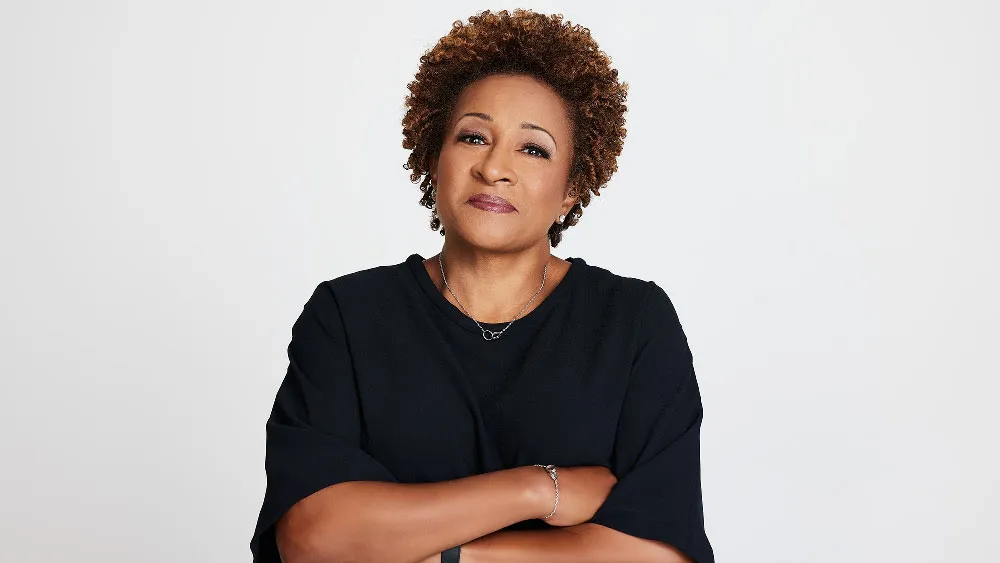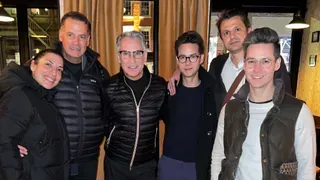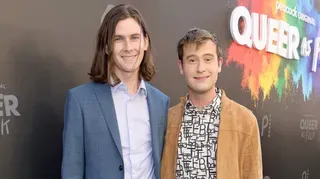September 12, 2022
Talking with 'Joyland' Filmmakers about their Queer Palm-Winning Movie
C.J. Prince READ TIME: 13 MIN.
In Saim Sadiq's directorial debut "Joyland," a family in Lahore, Pakistan finds their lives about to be permanently changed. Haider (Ali Junejo) lives with his wife Mumtaz (Rasti Farooq) in a house cramped by Haider's family: his father (Salmaan Peerzada), brother (Sohail Sameer), sister-in-law (Sarwat Gilani), along with their four children. Mumtaz is the breadwinner in the marriage while Haider can't find a job, and this role reversal combined with them not having any children creates a low-lying tension within the household.
Haider soon gets a job through his friend as a backup dancer for trans performer Biba (Alina Khan) at a theater hosting erotic dance shows, and while it pays, he keeps his new role a secret from his family out of shame. But the job opens Haider's eyes to a world he's never seen before, and soon he finds himself falling for Biba, while at home Mumtaz finds herself increasingly despondent at how her own desires clash against the traditional role of wife and mother everyone wants her to play.
Through Haider, Mumtaz, Biba, and even Haider's family, "Joyland" tackles themes of masculinity, gender identity, binaries, and conformity with a sensitive and humanist perspective. As much as the film may focus on these three characters, Sadiq's writing and direction frequently changes perspectives through composition and editing, with each frame placing its subjects within spaces that reflect their psychological states. It's a decentralized approach that puts empathy at the forefront, where each person's own desires and struggles are as valid as anyone else's.
After the success of his 2019 short film "Darling" (which also starred Alina Khan), "Joyland" premiered at Cannes earlier this year, where it made history as the first Pakistani film selected by the festival. It then went on to win a Jury Prize and the Queer Palm after a rapturous reception at the festival. EDGE spoke to writer/director Saim Sadiq and producer Apoorva Charan after Cannes, where they were still reeling from the film's success. Read on to find out more about the film's journey, Alina Khan's breakout performance, and how Sadiq developed the film's visual language.
EDGE: You said it took at least seven years to get "Joyland" made as a feature. Could you talk about your journey from the origin point to when you got to the final product?
Saim Sadiq: I don't even remember the full [journey] because there's so much that has happened. Even though it was seven years, I was writing for a big chunk of that. When I started writing it, I was in school, there were no stakes attached to it, [but] there were emotional stakes because I knew that I wanted this to be my first film. And then Apoorva came on board, and she also knew that she wanted it to be her first feature [as a producer]. You gradually start developing the script and more and more stakes get attached. Once "Darling" had been made and we both graduated, that's when a bit more stakes started getting attached to it, because you don't have schoolwork to do anymore that can sort of take over [your time].
I think the bulk of the actual work was done in the last two and a half to three years. What I wanted to do seven years ago became clearer for me as I came closer to shooting the project. It was [initially] a germ of an idea which had something to do with these three central characters, and I knew that it was going to explore this family and these themes. I would always write drafts, but it evolved in a certain way where it became more empathetic as we came closer and closer to the shoot. I [also] grew up, I became a less angsty person, a less judgmental person myself, so I was able to write these characters with less judgment as a writer, which I think is a great thing. For me it's a great journey with a very quick and fast climax, which we're still in right now.
Apoorva Charan: Saim and I met at Columbia [University], I think that's where we started collaborating. We say it was seven years, but it was really like building blocks. Every year something would happen that would get us a little bit closer to making this film that was instrumental in our evolutions as people and our professional development.
And then with "Darling" I felt so ready to make a feature to produce [since] I've done so many shorts. In terms of the logistics of producing, I felt like I was ready to make a feature, and I think we both were desperate to do what we like. Once Saim knows he's a writer and director, and I know I'm a producer, then we're desperate to put our craft into the world. I was working as an assistant for producers, working at Disney assisting executives, and you do some of the producing duties on things but it's not your own project.
EDGE: Location is so vital to what goes on in "Joyland." The title is a place, but there is also the setting of the theater. For Haider, the theater becomes something transformative for him, not just in the literal sense but also by being around people who are just so self-assured about themselves. How important was setting to you in developing your story?
Saim Sadiq: It was very important. I always knew that I was going to make a short film before I made the feature, and that short film was going to be very definitive for the [feature] and for my work. The short film was "Darling," which was my thesis, and it was only after "Darling" that what "Joyland" is became very clear to me. Doing the short film was integral because I needed to find the theater. It helps me write the feature's script because I know where things are, and I know the geography. This is a very old, magnificent location of a theater where it has these nooks and crannies and corridors and rooms which are amazing. The space has a story of its own, and it's the space that can do a lot of things. You see how the theater feels when it's completely empty, versus when it's completely packed with an audience. And you see that it can be a place of celebration, but it could also be a hiding spot for lovers even though it's such an open space.
It was the same thing for the house. We started looking for the house seven or eight months before the shoot because I needed to know what the house looks like, and you need to find the right house that matches what was on paper. I needed to see how people are going to move from one [room] to the other because the house had to be claustrophobic and intrusive, [where] anybody can come in from anywhere. We found this house where every room had three doors, and then there were three windows, so obviously there's no sense of privacy or intimacy possible because there's less wall and more doors. That becomes very informative and helps you a lot while you're shooting because you can block around it a certain way. I think we were lucky to find these two central locations.
EDGE: What drew you to wanting to tell a story involving a transgender character?
Saim Sadiq: It was always a story that was supposed to be about gender norms and sexuality, even at the stage of its germination. That was the one thing that was there and stayed the same, and she was one of the three characters we had at the very beginning. It was interesting for me to look at patriarchy and gender norms from the perspectives of a cisgender woman, a trans woman, and a man. It allowed me the space to write a story which was going to explore this organically and holistically. It wasn't a story about a particular brand of masculinity or a particular brand of femininity because [there are] other characters in the film. That happens organically, and it helps us see layers within the people around them. They might be gossiping about certain things related to our main characters and their desires, but they're kind of suffering from the same things.
The idea always was to keep it as a holistic study of the subject matter, and then having a trans character as a starting point was an obvious thing for me because they're a very important and visible part of our culture. It's not like trans people have sort of popped up and are becoming visible now, which is the case in a lot of the Western countries. Pakistan and India have a very long history of trans visibility. There are a lot of issues, but they've always been visible, and they've always been a very important and integral part of the social fabric. Everybody who's grown up in my city has seen trans people on the street, in the bazaar, in the markets, etc. so it's not like an alien thing. It wasn't a big decision for me to [include] trans characters, but of course it must be done with a certain amount of responsibility, research, and inclusion from the community itself and particularly Alina [Khan]. For me it was natural to be included in the story.
EDGE: Speaking of Alina Khan, this was her first feature after starring in "Darling." How did you meet her, and what was the casting process like for her with both films?
Saim Sadiq: Apart from the location, Alina was the other big asset where having her enabled us to do the film. I think it [helped] in a big way because we didn't have any of the cast a year and a half before shooting, and we knew that a lot of actors probably won't be very comfortable. We had to do auditions, especially for the guy's part, so that was a big job. Just having Biba there was a big relief for me because we didn't have to look for her too. We found her five days before the ["Darling"] shoot in almost like a generic casting process. She was not a trained actor by any stretch of the imagination at that point, which is in 2018, but there was a spark and a talent that I knew was there.
For "Joyland," we made sure that about four months before the shoot she knew that she had to leave everything and devote herself to the project, and she, myself, and Ali [Junejo] started working together. She had to get comfortable with Ali and he had to get comfortable with her. We had to build a character and make sure that whatever line she doesn't like or is not rolling off her tongue just needs to get changed because it's more important that she buys what she's saying, or to improvise here and there. Eventually she took complete ownership of the character, and it was a beautiful thing. To go from a non-actor to...I don't think you can call her a non-actor now. I think she's a phenomenal actor.
EDGE: Both "Darling" and "Joyland" are shot in the 4x3 Academy ratio. Can you talk about your decision to shoot in that format, as well as developing the visual language of your films?
Saim Sadiq: I just like it. [Laughs] I have intellectual explanations for all those things, and you do that to convince yourself and to convince the producer, the DP, or other technical crew. But it's like, when I prefer black over red, it's just that I prefer black. It's just a subjective taste thing, so that's the real truth. But I always do try to question it, and particularly with our DP Joe Saade, we had very long discussions. For "Joyland," we didn't decide on 4x3 until at least two months before the shoot. We had to see all the locations, to see if the film is going to be shot in spaces which have vertical lines more than horizontal lines because it just makes it easier for you to frame.
And then, it was such a character driven piece, and we were constantly shifting subjectivities between characters. It mostly follows Haider, but it does follow Biba and Mumtaz and sometimes even smaller characters. We knew that whenever we do a [perspective] switch we can associate with the character immediately, and this is a frame that cuts the space out and makes you look at the face far more than a Cinemascope or 16x9 [frame] would do. We wanted to attach the viewer to each subjectivity so that, when clashes happen between two characters or they want each other, it feels organic on a different level, which is not just plot driven. In that sense it helped a lot. And it has this claustrophobia also, which I don't think takes away from the grandeur or the fun of the theater, but I think it does add a lot to the claustrophobia of the house. These are the intellectual reasons.
EDGE: Seeing you talk about Joyland during Cannes, you spoke about how, by the very nature of this film's setting and characters, you could not make it Westernized; it could only be an ensemble and not a character study. Assuming that you grew up watching movies from the West, and that you also studied at Columbia, when you were developing the story did you need to be constantly aware of that? Did you ever have to think something might be too individualistic versus what's more appropriate for the story?
Saim Sadiq: I think the struggle was kind of the other way around in the writing process, where initially I did perhaps because I was in school. I was in a fantastic school, perhaps the best for screenwriting, but [it was] American. I have nothing against that, we've grown up watching and loving American movies, but the tools were all there for me. I was using those a bit too stringently, perhaps in the beginning of the writing process, and once I got out of school, I started shaking them off a bit or bending them here and there. I think coming back home [to Pakistan] to write the film also helped greatly. For the last two and a half or three years before "Joyland" was made I was living here, and I think that helped in the writing process psychologically.
Sometimes I think subconsciously that a person like a script doctor would look at [the screenplay] and say you're making a mistake. As a screenwriter, you shouldn't be jumping perspective or you shouldn't be giving this moment to this other character, you should give it to your protagonists. And I'm glad that I didn't [do those things]. I was very happy about that, because I think it's not just the fact that it was a film set in Pakistan, but also because of what the film was talking about. It helped me a lot in breaking binaries, because my protagonist was a man, and there were certain things that I just didn't want him to do, or certain moments that I didn't want him to get. I wanted another character, a female character, to get it because it felt more truthful and more correct.
EDGE: One of the things that stuck out to me about the film was how it has a very keen awareness of the social and political factors that get imposed on people, especially with regards to conformity. Haider and Mumtaz are dealing with issues around who they are, while Biba doesn't have these issues. She's certain of who she is, whereas the other characters are kind of in the process of figuring things out.
Saim Sadiq: One of the things that always interested me was that the strongest character in the film was the character of a trans girl. When you enter a film knowing or finding out that it has a trans character, you often expect them to be the most victimized, and ours was the least victimized. She was victimized in certain ways, of course, because that's part of the truth of the matter. But as a human being, as a character, her ethos was one that doesn't want to admit that she's a victim, which is a way of dealing with it. I also like the fact that the women around [Haider] all are all smarter than him. In a certain way, even Mumtaz knows far more than Haider does. She has that awareness about herself, about what she's giving up, and what her struggle is. Even if she's quieter, she's aware, but our boy is the most unaware of them all. I'm glad that the film's story maps out gender politics on a broader scale as well if a viewer wants to look at it [that way].
EDGE: Now that the film has premiered and gotten so much acclaim and awards, what have you found the reaction to be like in Pakistan?
Saim Sadiq: It's very beautiful, and I think that's important for all of us. Particularly for me, the biggest part of being overwhelmed is just seeing people around me responding and being so happy and celebrating the film. It's a rare thing for Pakistan to have something artistic that gets celebrated like this. I think it's a general celebration with people sort of owning the film as their own. It's only been positive so far.
Apoorva Charan: We haven't shared the film widely in Pakistan yet [since] we haven't had our release. I'm hoping that it continues to be overwhelmingly positive, and I think it will be because the film is so sensitive and kind to its characters. It's so caring to itself and to its audience that I'm hoping they will be kind back to us.







